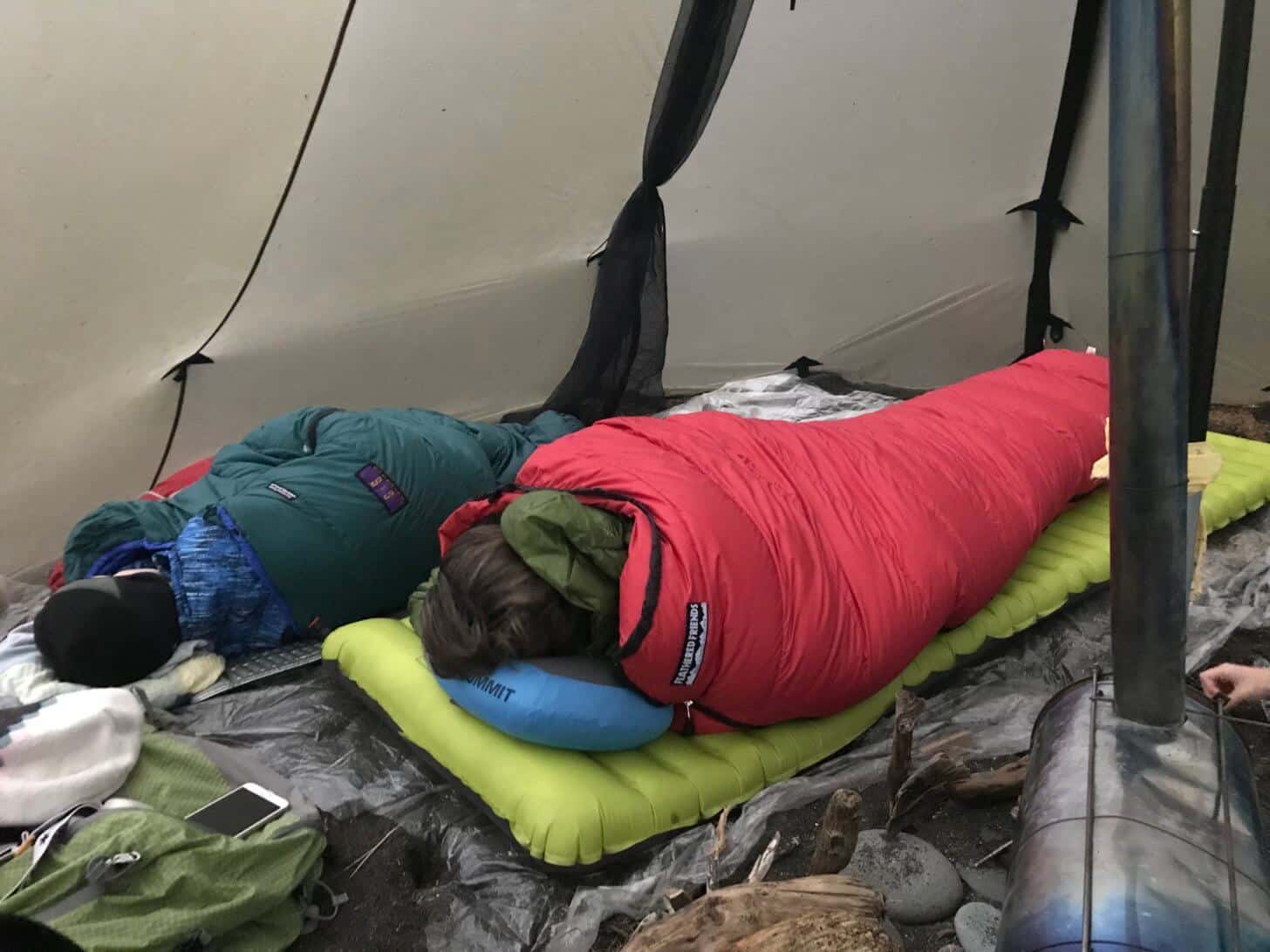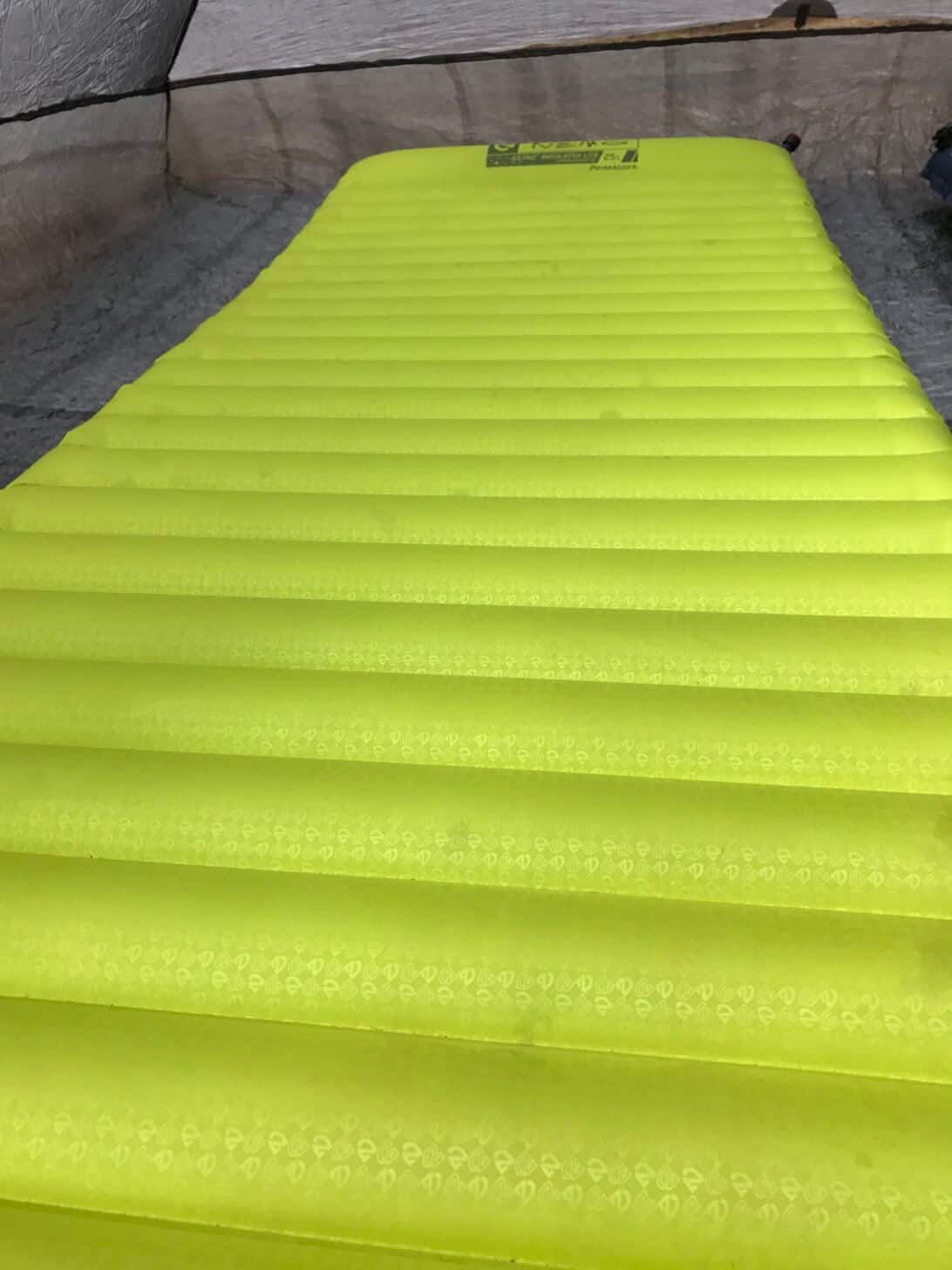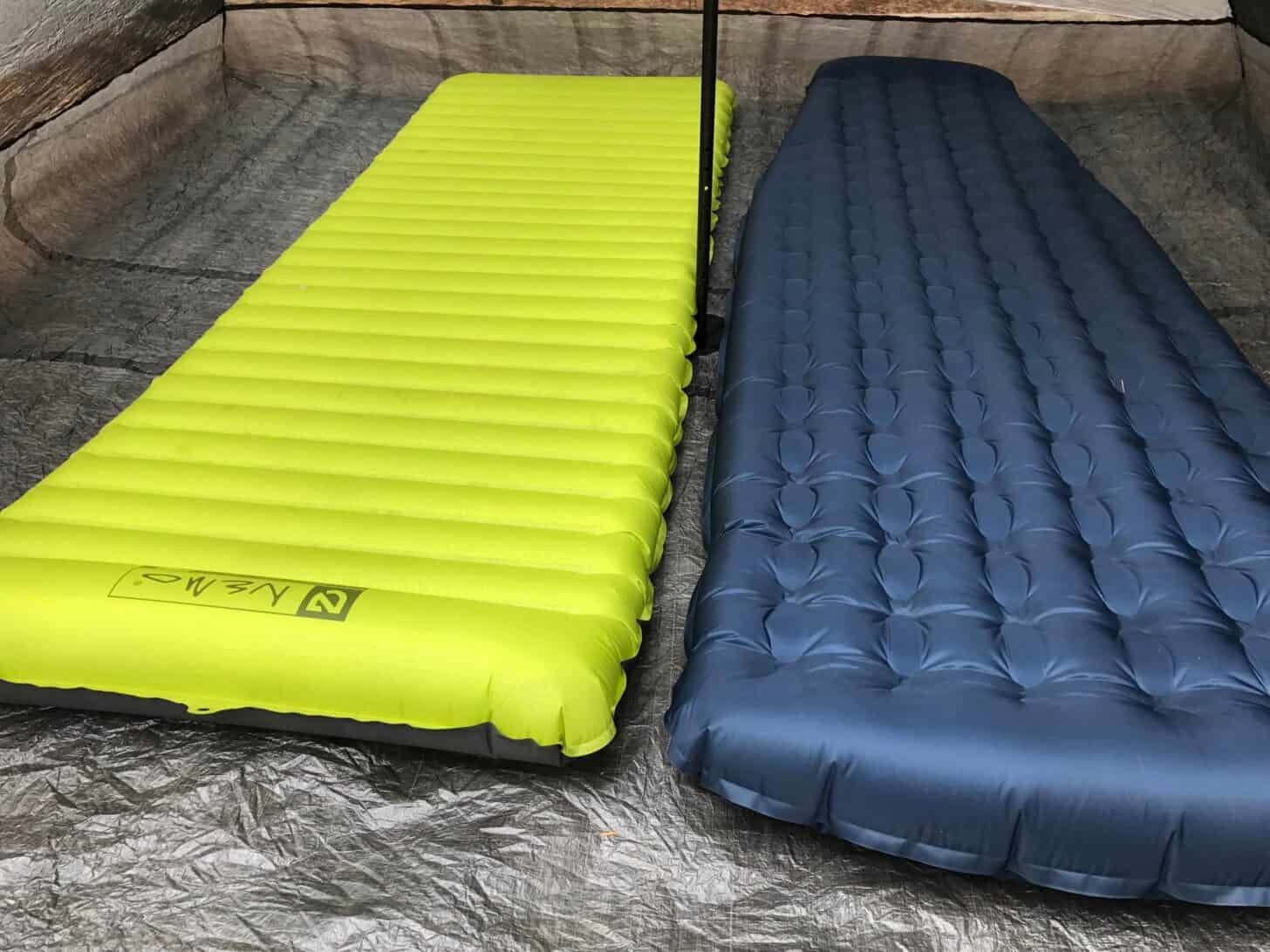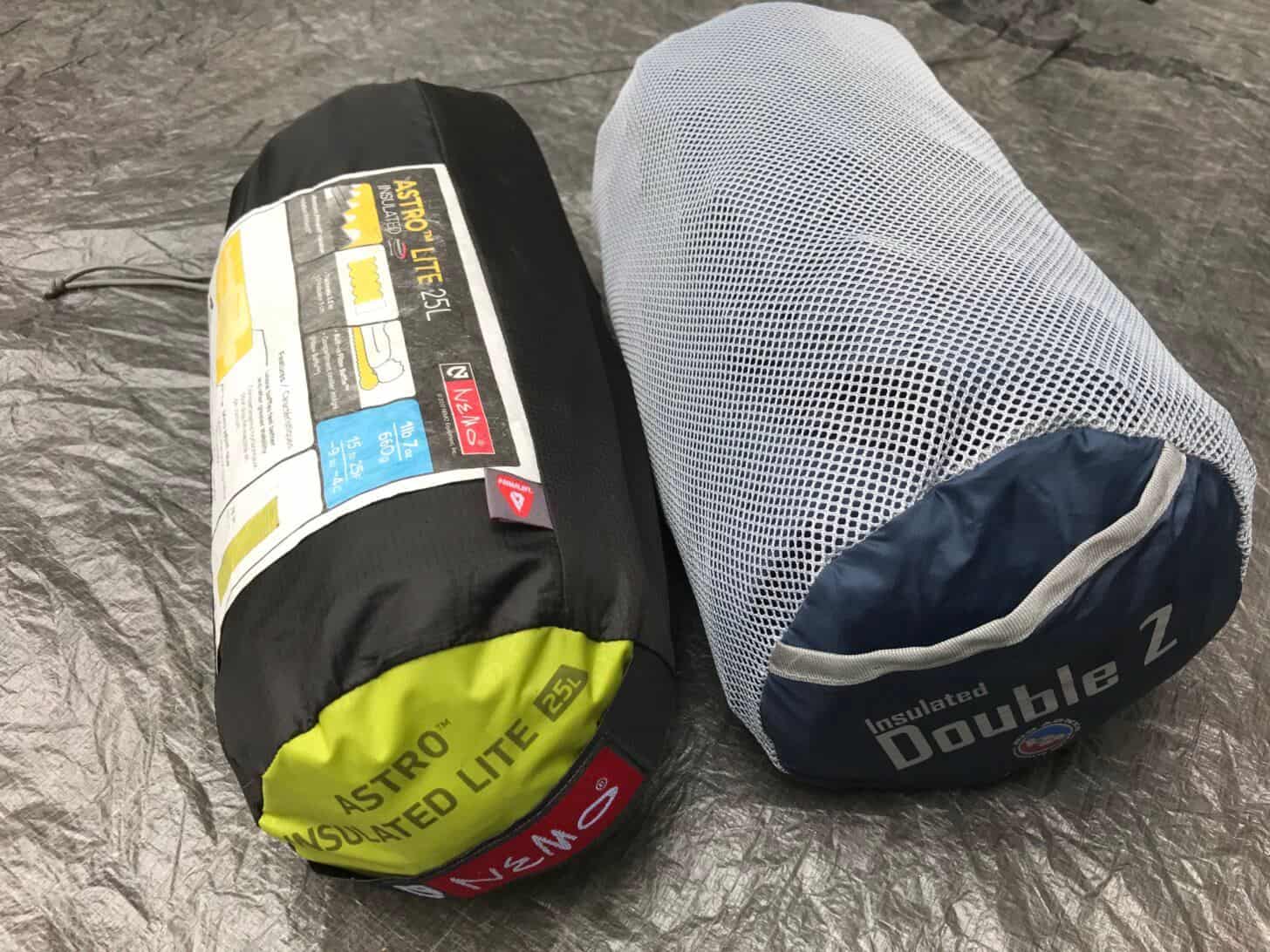Introduction
The Nemo Equipment Astro Insulated Lite 25L sleeping pad is a plush sleeping pad that adds a touch of luxury to backcountry sleeping. This unique pad may offer the best luxury-comfort-to-weight ratio of any sleeping pad ever manufactured.

Features and Specifications – 25L
25 refers to the pad width (25 in), and L refers to the long length (76 in). Don’t confuse this pad with the more conventionally-sized Nemo Astro Insulated 20R (20 in wide x 72 in long).
Features:
- PrimaLoft insulation
- Extra width (25 in) and length (76 in)
- Built-in pillow baffle
- Micro-adjust air valve
- Included stuff sack and repair kit
Specifications:
- Materials:
- 20D PU polyester ripstop fabric
- PrimaLoft insulation on the top of the pad
- Weight (pad only): 23.4 oz (664 g) measured (manufacturer claim: 23.0 oz)
- Weight (stuff sack and repair kit): 1.0 oz (29 g)
- Measurements: 25 in x 76 in (64 cm x 193 cm), rectangular shape
- Thickness: 3.4 in (8.6 cm) measured (manufacturer claim 3.5 in)
- Thickness at pillow baffle: 5.25 in (13.3 cm) measured
- Cost: $149.95
Review Context
I am currently working on an article for Backpacking Light about ultralight luxury. I’m exploring how an ultralight backpacker can add luxury items to an ultralight kit to increase backcountry comfort, enjoyment, and relaxation. For me, a luxury sleeping pad needs to meet the following criteria:
- It has to be 25 inches wide for stretching out
- It has to be at least 72 inches (6 feet) long
- It must be insulated for use in 3+ seasons
- It needs to be thick – thicker than my 2.5-inch NeoAir XLite
- It needs to be comfy!
These criteria come with a weight trade-off of course – for comparison, the long NeoAirXLite is 16 oz (0.45 kg).
Description of Field Testing
I field tested this pad on a variety of trip types, environments, and weather conditions over a six-month period. I used it on a ten-day canoeing and backpacking trip in Yellowstone National Park, a winter trip off the coast of Olympic National Park, and a glacier climb of Mount Adams in Washington’s Cascade Mountains. Temperatures ranged from 20 to 90 deg F (-7 to 32 deg C) during these trips.

Performance Assessment
My wife Amy and I spent our testing nights fighting over who got to sleep on the Astro. It is simply the most comfortable pad we have ever used in the backcountry (prior to reviewing the Big Agnes Insulated Double Z, that is).
At 3.4 inches thick (my measurement), the Astro sleeping pad is 36% thicker than a Thermarest NeoAir XLite pad. It has similar horizontal baffles (i.e., baffles that are perpendicular to the length of the body) that are more comfortable than vertical baffles (i.e., baffles that are parallel to the length of the body), especially on a pad this thick. The additional thickness means that you can decrease air pressure to settle into the pad and still be suspended off of the ground.

The Astro utilizes a Micro-Adjust valve to fill, empty, and adjust the air pressure in the pad. The valve extends for filling or to release air in small amounts. It pushes closed and turns to lock. There is no screwing needed with this valve. It’s easy to make small adjustments while laying on the pad – just pop open the valve to release air or to add a few puffs. This is a useful feature in a high volume air pad, where small changes in air pressure can make a huge difference in comfort.
Inflating the Astro takes more work than most other pads. While inflating with lung power is possible, I preferred to use a Camp-Tek Microburst or NeoAir Mini Pump with the pad. An inflation bag is also a good alternative with this pad. Deflation is not as fast as with a “quick dump” valve found on some other pads, but it is typical of many other backpacking air pads. Laying on the pad during deflation speeds things up.
This pad is the large version, which is 25 inches (64 cm) wide and 76 inches (193 cm) long. The added width allows for broad shoulders and gives stomach sleepers room to spread out their arms. Parents can use the extra space to snuggle up with a small child. The length allows tall hikers to keep their legs completely on the pad. This is especially important with a thick air pad because legs hanging off all that height is uncomfortable. You will need to take tent size into account with a pad this wide. For example, two of these pads will fit inside a Tarptent Double Rainbow but will be a bit too wide for a Zpacks Duplex.

The Astro includes a pillow baffle at the head end of the pad, providing an additional two inches of thickness. For back or stomach sleepers, the additional thickness may be enough to leave a pillow at home. When using a pillow, the baffle holds the pillow in place and boosts a pillow’s height. I was surprised at just how much I loved this feature – it worked well in the field and added a significant amount of comfort to the sleeping experience.
Primaloft insulation enables this air pad to be used well beyond the summer months. I tested this pad down to about 20 deg F and found it to be as warm as most insulated air pads. Compared to a Thermarest NeoAir XTherm, the Nemo is not as warm. I doubt if it would be a great pad on the snow. However, I slept warm in my quilt in a variety of three-season conditions. The Primaloft insulation is attached to the top (green side) of the pad – sleep with the green side up for extra warmth or with the grey side up for summer nights.
The primary drawback of air pads is the potential for leaks. I never experienced a leak while using the Astro, including after two nights of sleeping on rough volcanic gravel. Regardless, carrying a patch kit while using an air pad is always a good idea.
I found the durability of this pad to be excellent. The Astro comes with a patch kit, and the included stuff sack holds both pad and kit.
This sleeping pad is expensive, retailing at $149.95. However, it’s cheaper than a comparable NeoAir and similarly priced to other insulated air pads on the market. I think this pad is a good value, given the features and durability.
Product Strengths and Limitations
Strengths
I am pleased with the performance of the Nemo Equipment Astro. It is a luxury item that I bring on the majority of my trips for the following reasons:
- This pad is comfortable. The pillow baffle is a great feature that eliminates the need for a separate pillow for back or stomach sleepers and reduces the pillow thickness needed for side sleepers.
- It is warm. I was able to use this pad in below freezing conditions and slept warm. It’s not as warm as my NeoAir XTherm winter pad, but it’s as warm as most three-season pads I’ve used.
- The horizontal baffles are comfortable and supportive.
- It is durable. After many nights, including two nights camping on volcanic rock, the pad is not leaking.
- The Micro-Adjust air valve makes it easy to get just the right air pressure.
- $149.95 is a reasonable price for this pad.
- I sleep better on this pad!
Limitations
- Not all tents have the width for wider pads, especially when sleeping double in a two-person tent. Be sure to check your tent’s width before switching to a wide pad (this pad is available in a standard 20-inch width as well).
- It takes significant lung power to inflate a pad this big. A dedicated inflator such as the Camp-Tek Microburst, NeoAir Mini Pump, or an inflation bag like the Exped Schnozzel is very useful when inflating this pad.
- The thickness fell a tiny bit short of the manufacturer’s claim of 3.5 in, no matter how firmly I inflated it. I measured its maximum thickness at 3.4 in.
Compared to…
There are quite a few options on the market when looking for large, luxurious air pads. I have extensive experience with the Thermarest NeoAir XLite large and the Big Agnes Insulated Double Z:
Thermarest NeoAir XLite – Long
- 2.5 inches thick (.9 inches less thick than the Astro)
- 16 ounces (7.4 ounces lighter than the Astro)
- Tapered mummy shape (vs. the rectangular Astro)
- No built-in pillow
- $50 more expensive at $199.95
Big Agnes Insulated Double Z – 25” x 78”
- 4 inches thick (.6 inches thicker than the Nemo)
- 29.9 ounces (6.5 ounces heavier than the Nemo)
- Tapered foot end (vs. the rectangular Nemo)
- Smaller built-in pillow
- Identical price – $149.95
I found the Nemo Astro Insulated Lite sleeping pad to be more comfortable than the NeoAir pad. The comfort of the Nemo and Big Agnes pads were much more comparable. The heavier and thicker Big Agnes was more comfortable, but not by much.


Commentary
I’m sold on the Nemo Equipment Astro Insulated Lite sleeping pad. It is not the lightest of pads at just under 1.5 pounds, but it may provide the best comfort to weight ratio on the market. It has the width to spread out, the length to keep my long legs on the pad, and the insulation to bring it into sub-freezing conditions. The Micro-Adjust valve is easy to adjust while lying on the pad, allowing you to get the air pressure dialed in for maximum comfort. The built-in pillow baffle is a well-thought-out feature. My wife and I loved this pad so much that we bought a second one – no more backcountry arguments over the Nemo pad! I highly recommended this insulated air pad.
Where to Buy
Related Content
- Our members discuss pad inflation tools and techniques here, here, here, here, and here.
- Check out Doug’s review of the Big Agnes Insulated Double Z.
Disclosure
Product(s) discussed in this review were either acquired by the author from a retailer or otherwise provided by the manufacturer at a discount/donation with no obligation to provide media coverage or a product review to the manufacturer(s). Backpacking Light does not accept compensation or donated product in exchange for guaranteed media placement or product review coverage. Some (but not all) of the links in this review may be “affiliate” links, which means if you click on a link to one of our affiliate partners (usually a retailer site), and subsequently make a purchase with that retailer, we receive a small commission. This helps us fund our editorial projects, podcasts, instructional webinars, and more, and we appreciate it a lot! Thank you for supporting Backpacking Light!



Home › Forums › Nemo Equipment Astro Insulated Lite 25L Sleeping Pad Review